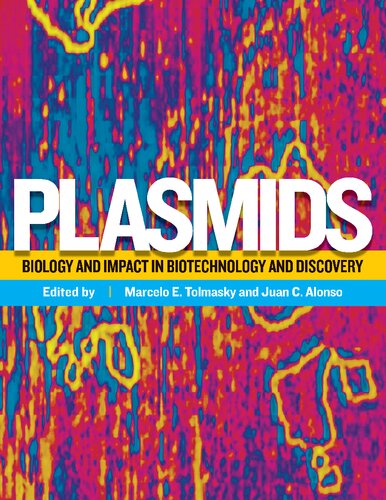

Most ebook files are in PDF format, so you can easily read them using various software such as Foxit Reader or directly on the Google Chrome browser.
Some ebook files are released by publishers in other formats such as .awz, .mobi, .epub, .fb2, etc. You may need to install specific software to read these formats on mobile/PC, such as Calibre.
Please read the tutorial at this link. https://ebooknice.com/page/post?id=faq
We offer FREE conversion to the popular formats you request; however, this may take some time. Therefore, right after payment, please email us, and we will try to provide the service as quickly as possible.
For some exceptional file formats or broken links (if any), please refrain from opening any disputes. Instead, email us first, and we will try to assist within a maximum of 6 hours.
EbookNice Team

Status:
Available0.0
0 reviews
ISBN 10: 1555818978
ISBN 13: 9781555818975
Author: Marcelo Tolmasky, Juan C Alonso
Explore the remarkable discoveries in the rapidly expanding field of plasmid biology Plasmids are integral to biological research as models for innumerable mechanisms of living cells, as tools for creating the most diverse therapies, and as crucial helpers for understanding the dissemination of microbial populations. Their role in virulence and antibiotic resistance, together with the generalization of "omics" disciplines, has recently ignited a new wave of interest in plasmids. This comprehensive book contains a series of expertly written chapters focused on plasmid biology, mechanistic details of plasmid function, and the increased utilization of plasmids in biotechnology and pharmacology that has occurred in the past decade. Plasmids: Biology and Impact in Biotechnology and Discovery serves as an invaluable reference for researchers in the wide range of fields and disciplines that utilize plasmids and can also be used as a textbook for upper-level undergraduate and graduate courses in biotechnology and molecular biology.
I. Introduction
1. Historical Events That Spawned the Field of Plasmid Biology
II. Plasmid Replication Systems and Their Control
2. Iteron Plasmids
3. Mechanisms of Theta Plasmid Replication
4. Plasmid Rolling-Circle Replication
5. Replication and Maintenance of Linear Phage-Plasmid N15
6. Plasmid Replication Control by Antisense RNAs
7. Topological Behavior of Plasmid DNA
III. Plasmid Maintenance, Transfer and Barriers
8. Plasmid Partition Mechanisms
9. Resolution of Multimeric Forms of Circular Plasmids and Chromosomes
10. Conditional Activation of Toxin-Antitoxin Systems: Postsegregational Killing and Beyond
11. The Interplay between Different Stability Systems Contributes to Faithful Segregation: Streptococcus pyogenes pSM19035 as a Model
12. The CRISPR-Cas Immune System and Genetic Transfers: Reaching an Equilibrium
13. Plasmid Diversity and Adaptation Analyzed by Massive Sequencing of Escherichia coli Plasmids
14. Conjugation in Gram-Positive Bacteria
15. Mobilizable Rolling-Circle Replicating Plasmids from Gram-Positive Bacteria: A Low-Cost Conjugative Transfer
IV. Specific Plasmid Systems
16. The Plasmid Mobilome of the Model Plant Symbiont Sinorhizobium meliloti: Coming up with New Questions and Answers
17. The Agrobacterium Ti Plasmids
18. The Influence of Biofilms in the Biology of Plasmids
19. The Partitioning and Copy Number Control Systems of the Selfish Yeast Plasmid: An Optimized Molecular Design for Stable Persistence in Host Cells
20. Plasmids from Euryarchaeota
V. Plasmid Ecology and Evolution
21. The Plasmidome of Firmicutes: Impact on the Emergence and the Spread of Resistance to Antimicrobials
22. Plasmid-Mediated Antimicrobial Resistance in Staphylococci and Other Firmicutes
23. Plasmid Detection, Characterization, and Ecology
24. Plasmid-Mediated Antibiotic Resistance and Virulence in Gram-Negatives: The Klebsiella pneumoniae Paradigm
25. Plasmid-Mediated Quinolone Resistance
VI. Specialized Functions Mediated By Plasmids
26. Plasmid-Mediated Tolerance Toward Environmental Pollutants
27. Virulence Plasmids of Spore-Forming Bacteria
28. Virulence Plasmids of Nonsporulating Gram-Positive Pathogens
29. Plasmid-Encoded Iron Uptake Systems
VII. Plasmids as Genetic Tools
30. DNA Assembly Tools and Strategies for the Generation of Plasmids
31. Plasmids as Tools for Containment
32. Mining Environmental Plasmids for Synthetic Biology Parts and Devices
33. Using Plasmids as DNA Vaccines for Infectious Diseases
34. Plasmid Biopharmaceuticals
Index
plasmid in biotechnology
biotechnology overview pdf
plasmids and biotechnology
microbes and biotechnology
plasmids in biological research
impact of biotechnology on individual society and the environment
Tags: Marcelo Tolmasky, Juan C Alonso, biology, biotechnology